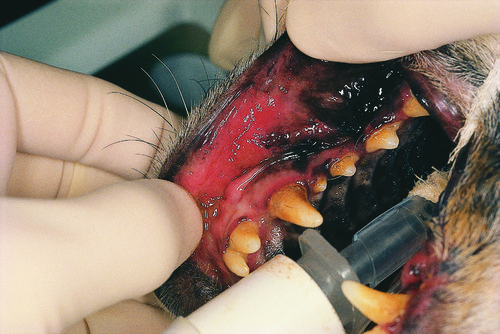Difference between revisions of "Veterinary Dentistry Q&A 15"
Ggaitskell (talk | contribs) |
|||
| Line 1: | Line 1: | ||
| + | {{Template:Manson | ||
| + | |book = Veterinary Dentistry Q&A}} | ||
| + | |||
[[File:Vet Dentistry 15.jpg|centre|500px]] | [[File:Vet Dentistry 15.jpg|centre|500px]] | ||
Revision as of 22:56, 12 October 2011
| This question was provided by Manson Publishing as part of the OVAL Project. See more Veterinary Dentistry Q&A. |
This dog had a history of a shifting limb lameness. In addition to findings noted in the oral cavity, the clinical and laboratory examination revealed lethargy, mild peripheral lymphadenopathy, mild fever, and confirmed proteinuria with no other abnormalities on a complete urinalysis. The results of a complete blood count and biochemical profile were within normal limits.
| Question | Answer | Article | |
| This patient should be evaluated for which autoimmune disease? | Systemic lupus erythematosus (SLE) is an autoimmune disease that affects multiple organ systems. Polyarthritis and/or polymyositis are common in SLE and may result in a stiff gait or a shifting limb lameness. Cutaneous lesions are common and include lesions affecting the body, limbs, head, mucocutaneous junctions, and oral cavity. Major signs of SLE include non-erosive polyarthritis, polymyositis, bullous dermatitis, proteinuria, and immune-mediated hemolytic anemia and/or thrombocytopenia and/or leukopenia. Minor signs include oral ulceration, pleuritis, myocarditis, pericarditis, peripheral lymphadenopathy, fever of unknown origin, dementia, and seizures. |
[[|Link to Article]] | |
| Which diagnostic tests are indicated to evaluate for autoimmune disease? | The diagnosis of SLE is based on a combination of clinical signs and laboratory tests. The extent of the diagnostic evaluation is determined by the clinical signs and initial laboratory database. Serologic tests used to support a diagnosis of SLE include an indirect fluorescent antinuclear antibody test (ANA test) and lupus erythematosus cell test (LE cell test). The diagnosis of SLE is usually made when two major signs are present with a positive serologic test. A probable diagnosis is made when one major sign and a positive serologic test are present or two major signs with negative serologic tests. When evaluating the results of ANA and LE cell test results the laboratory should be consulted to determine the significance of the ANA titers and the possibilities for false-positive and false-negative results. |
[[|Link to Article]] | |
